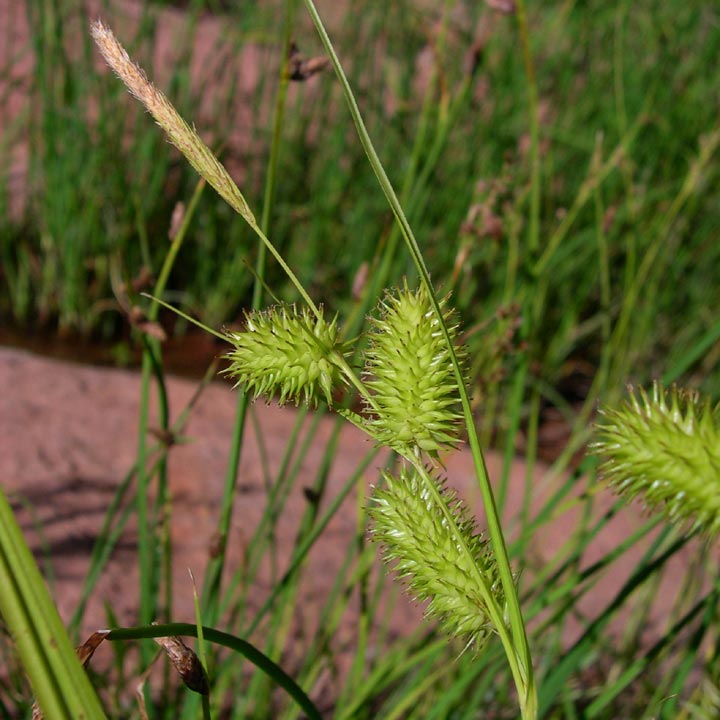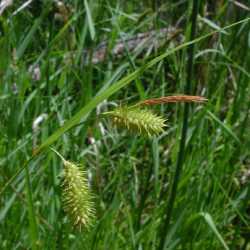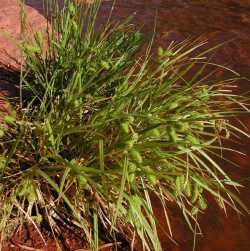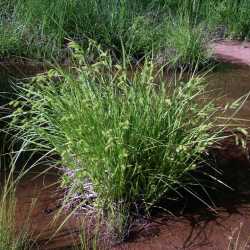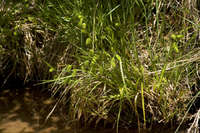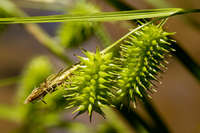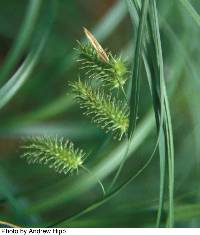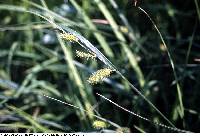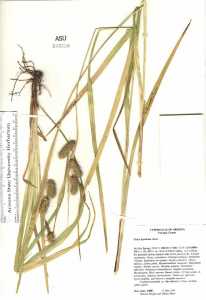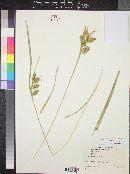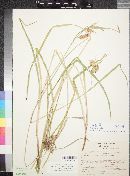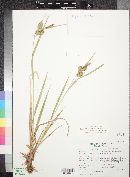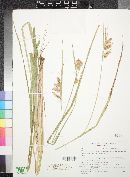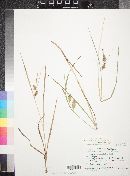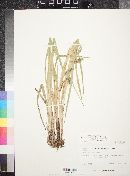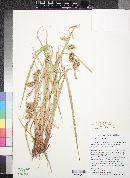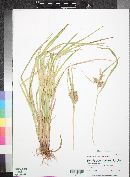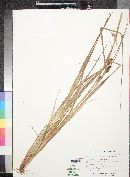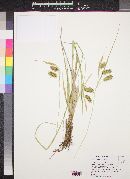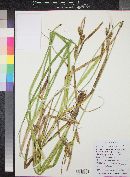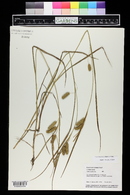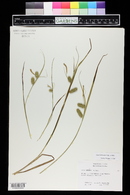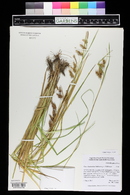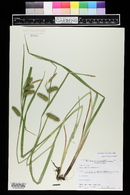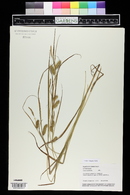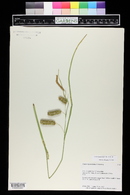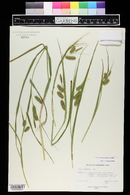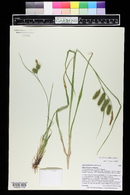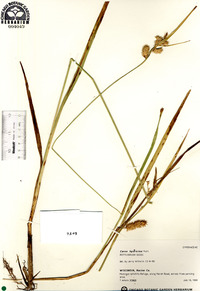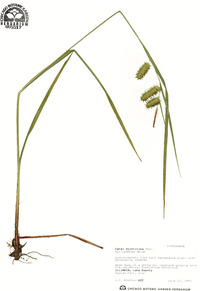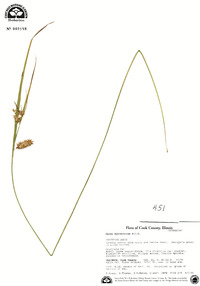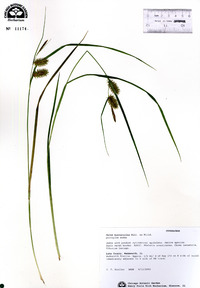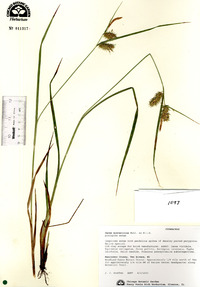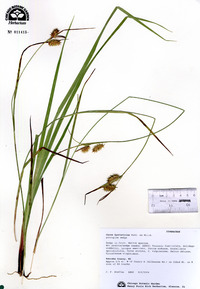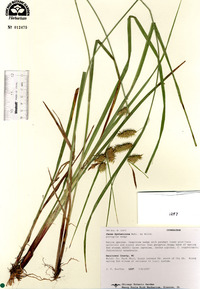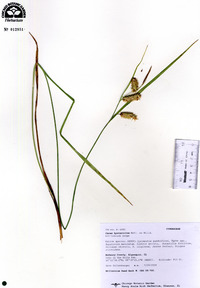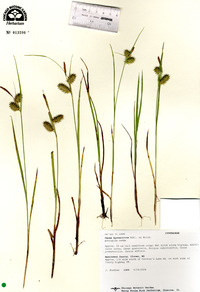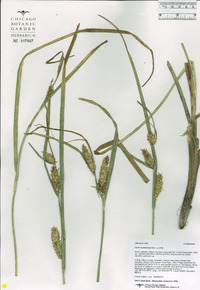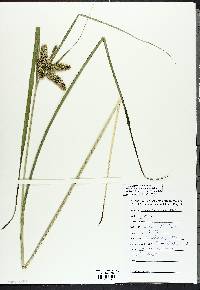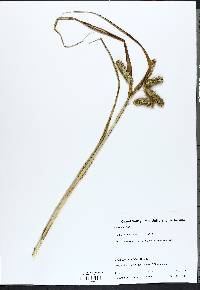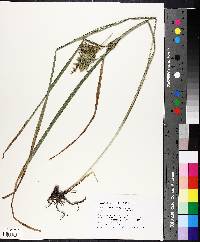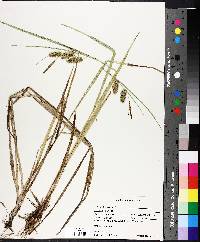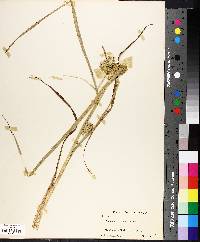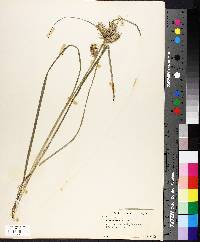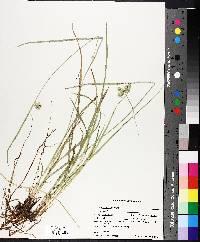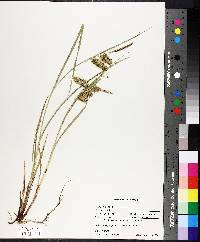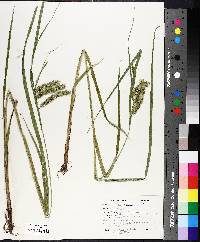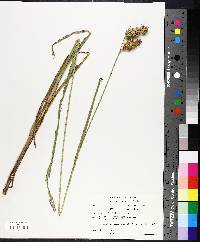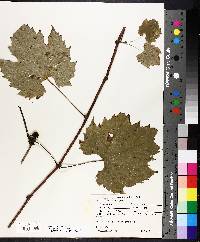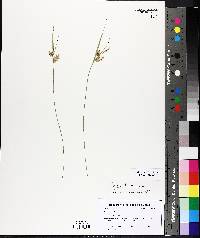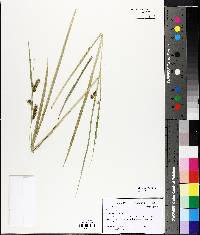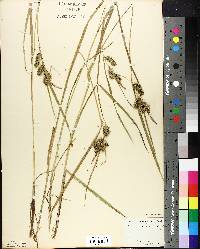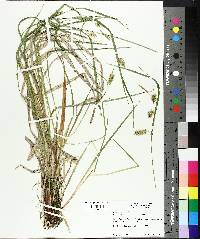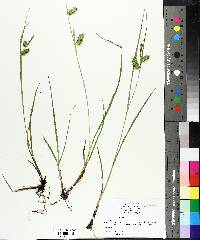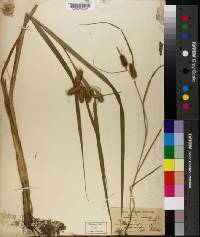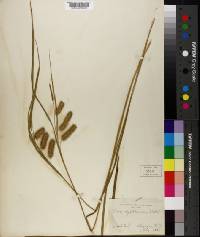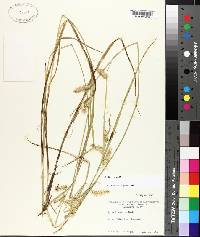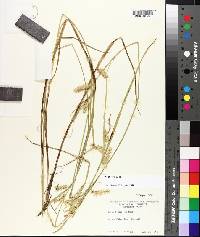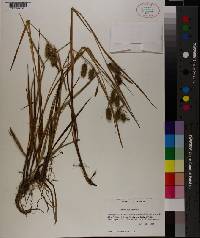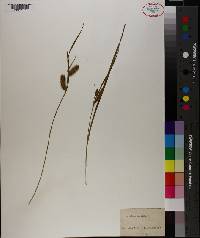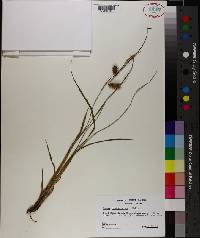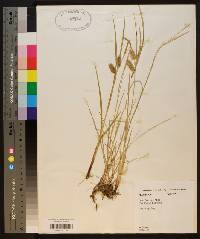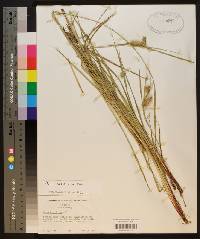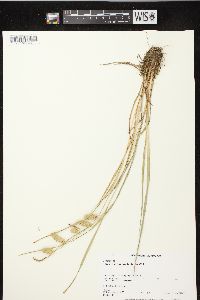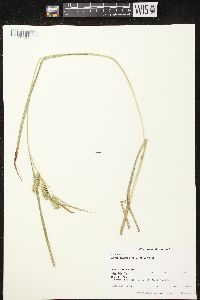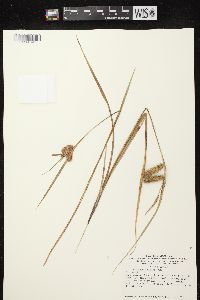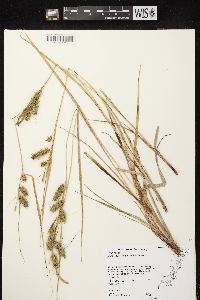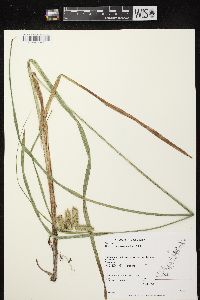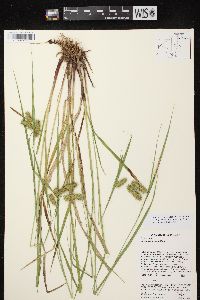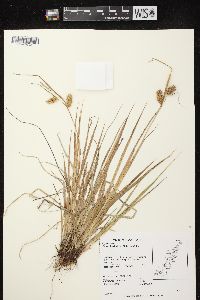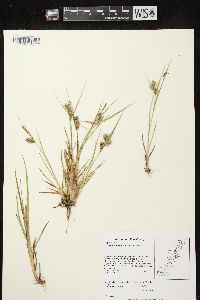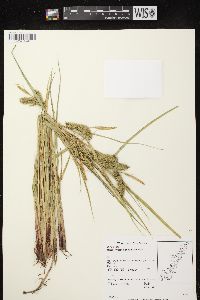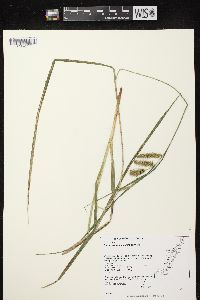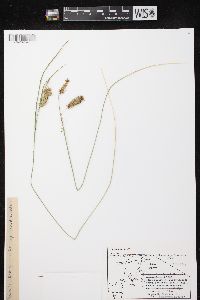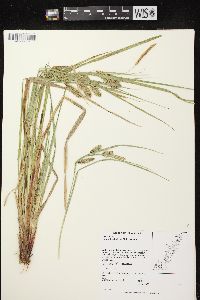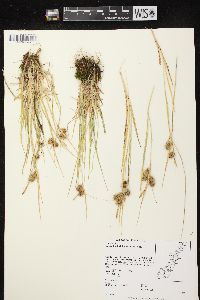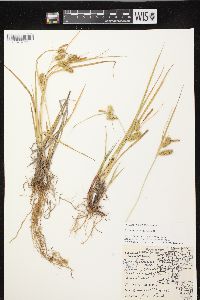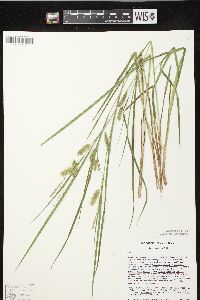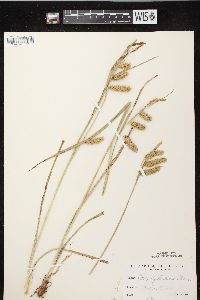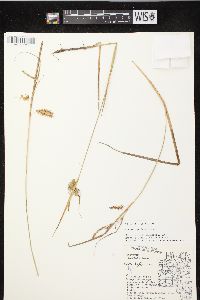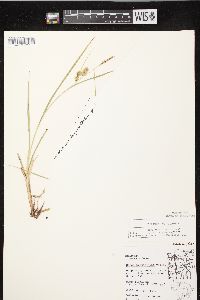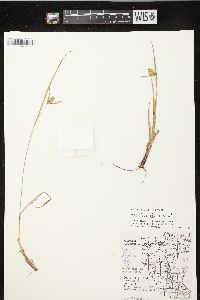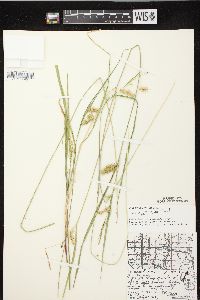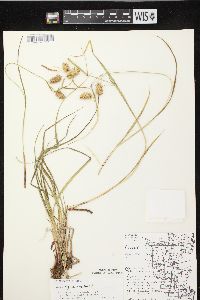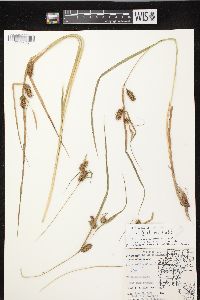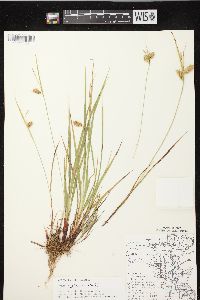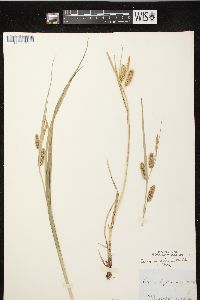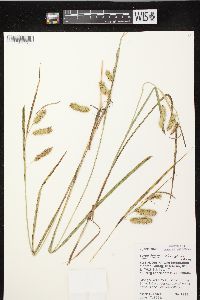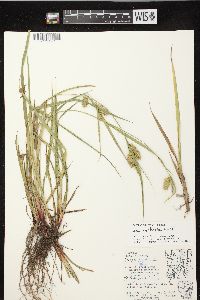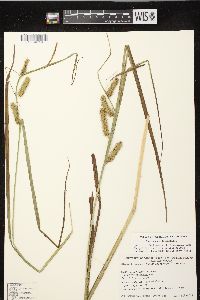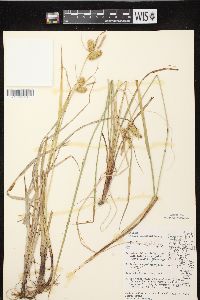Carex hystericina
|
|
|
|
Family: Cyperaceae
bottlebrush sedge, more...Porcupine Sedge
[Carex cooleyi, moreCarex georgiana Dewey ex Steud., Carex hystericina var. dudleyi] |
Plants densely to loosely cespitose; rhizomes short, no more than 10 cm. Culms trigonous in cross section, 20-100 cm, scabrous-angled distally. Leaves: basal sheaths usually strongly tinged with reddish purple; ligules longer than wide; blades pale to mid green, flat to W-shaped, 2.5-8.5 mm wide, glabrous. Inflorescences 2.5-12(-20) cm; proximal bract 4-30 cm, exceeding inflorescence; proximal (1-)2-3(-4) spikes pistillate, erect or often the proximal pendent; terminal 1 spike staminate. Pistillate scales lanceolate, 2.3-6.5 × 0.5-1.1 mm, shorter than perigynia, margins ciliate, , apex truncate to retuse, scabrous-awned, awn longer than body. Staminate scales scabrous-awned, sometimes also ciliate-margined. Perigynia spreading or the proximal reflexed, strongly 13-21-veined, veins mostly separated by 3+ times their width, confluent at or proximal to mid beak (except for 2 prominent lateral), elliptic, 4.5-7.3 × 1.4-2.1 mm, herbaceous, apex contracted; beak 1.9-2.8 mm, smooth, bidentulate, teeth straight, 0.3-0.9 mm. Stigmas 3. Achenes pale brown, trigonous, smooth. Fruiting May-Jul. Open swamps, sedge meadows, fens, stream, pond, and lakeshores, seeps, springheads, ditches, mostly in calcareous soils; 0-2000 m; B.C., Man., Nfld. and Labr., N.S., Ont., Que., Sask.; Ark., Conn., Ill., Ind., Iowa, Kan., Mass., Mich., Minn., Mo., Mont., Nebr., N.J., N.Mex., N.Y., Ohio, Pa., S.Dak., Tenn., Tex., Utah, Va., W.Va., Wis., Wyo. Common Name: bottlebrush sedge Duration: Perennial Nativity: Native Lifeform: Graminoid Notes: This is a densely tufted sedge with a terminal staminate spike(s) and pendulous lateral pistillate spikes, with inflated perigynia and pistillate flowers with 3 stigmas. It is most closely related to Carex thurberi, both of which share awned pistillate scales. In Carex hystericina, the scabrous awn is as long or longer than the scale body, while in C. thurberi, the awn is shorter. The lateral pistillate spikes in Carex hystericina tend to be shorter and broader, looking more like a -bottle-brush-, while those of C. thurberi are longer and finer textured. Carex ultra has a similar inflorescence morphology, but is a more robust plant with stiff coriaceous leaves with rough edges, and its perigynia are widest near the top, while those of C. hystericina and C. thurberi are widest at the base. Carex ultra rarely has short scale awns, while those of C. thurberi and C. hystericina are longer. Carex lenticularis and C. senta also share this inflorescence type, but have perigynia that are flat with lenticular achenes, and pistillate flowers with 2 stigmas. (Notes: Max Licher and Glenn Rink 2012) Etymology: Carex is the classical Latin name for the genus, while hystericina Synonyms: None Stems 3-10 dm, rather slender, clustered on a short, stout rhizome; lvs tending to be septate-nodulose (especially the sheaths), the long flat blade 3-9 mm wide; bracts subtending the lowest pistillate spike sheathless or with only a short sheath, and with a long blade somewhat surpassing the infl, the other bracts much reduced or wanting; terminal spike staminate, 2-4 cm; pistillate spikes several, approximate or the lowest one remote, 1.5-4 נ1-1.5 cm, the lower ones loosely nodding on slender, flexuous peduncles, the uppermost often subsessile and loosely ascending-spreading; pistillate scales with a short, largely scarious or hyaline body only 1-2 mm and a prominent rough awn-tip2-6 mm; perigynia very numerous, densely crowded, mainly spreading or ascending-spreading, usually pale greenish, 5-7 mm, prominently (12-)15-20-nerved, thin-textured, slightly inflated and nearly round in cross-section, scarcely stipitate, lanceolate or lance-ovate, rather abruptly tapering to the conspicuous, slender beak with short straight teeth 0.3-0.9 mm; achene trigonous, loose in the lower half of the perigynium, continuous with the persistent, bony style, which becomes flexuous or contorted as the achene matures; 2n=58. Swamps, wet meadows, and shores; N.B. and Que. to Wash., s. to Va., Ky., Tex., and Calif. Gleason, Henry A. & Cronquist, Arthur J. 1991. Manual of vascular plants of northeastern United States and adjacent Canada. lxxv + 910 pp. ©The New York Botanical Garden. All rights reserved. Used by permission. From Flora of Indiana (1940) by Charles C. Deam Common in most of the glaciated area of Indiana in swamps and wet habitats of all types but usually in calcareous soils. No corroborating specimen for Schneck's report from the Lower Wabash Valley could be found. ...... Indiana Coefficient of Conservatism: C = 5 Wetland Indicator Status: OBL |
|
|
|

